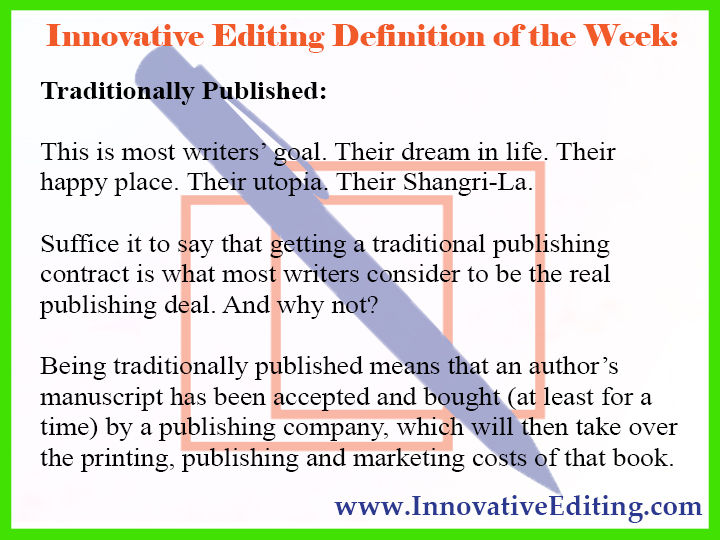Traditionally Published: Achieving Every Writer’s "Shangri-La”
- Jeannette DiLouie
- Aug 1, 2017
- 3 min read

So far this year, we’ve covered Creative Writing 101, what it takes to get your story down on paper, and how to properly edit your manuscript. That means we’re now ready to talk about the publishing process for today’s writing Definition of the Week, as posted on Innovative Editing’s Facebook page.
To start out on this newest chapter of your writing journey, let’s first acknowledge that there’s more than one way to publish a book. In fact, three different types of publishing options exist, leaving go-getting writers to be:
Traditionally published
Self-published
Published by a vanity press.
We’re going to explore all three of these choices over the next month or so, going into their pros – if they have any – and cons. But for this week, we’re focusing exclusively on that first bullet point. And for today in particular, we’re asking the big question of:
What does it mean to be traditionally published?
When most autobiographical, non-fiction and creative writers think about being traditionally published, they think about striking it rich J.K. Rowling-style or dominating an entire genre like Max Lucado.
Being traditionally published is most writers’ goal. This is their dream in life. Their happy place. Their utopia. Their Shangri-La.
When they think about this state of authorial existence, the birds are always singing, the peasants are always rejoicing, and everyone is always breaking out into song like they’re in a Disney animated film.
To many novice and professional writers, writing communities and even readers, this is the one and only sign of real success in the publishing world.
Suffice it to say that getting a traditional publishing contract is what most writers consider to be the real deal. And whether that’s entirely true or not, they’ve got some good reason to think like that.
Speaking as a self-published author, I’ll still be the first person to admit that being traditionally published is the only way an author can automatically and assuredly get paid for his or her manuscript. The other currently available options out there promise no such thing, as we’ll see later.
When a writer gets a traditional publishing offer, it means that some publishing company out there likes the look of their manuscript enough to offer money for it. It means that some industry insider has deemed the story worth investing in: that an established publishing company is willing to offer an up-front amount of money and (almost always, if not always) a promise of royalty payments in exchange for the temporary or total rights to that manuscript.
There’s always a contract involved in the traditional publishing process, specifying the ins and outs of who gets what for what price. But the general agreement is going to be that the writer gets paid something for all the original work they did in creating the manuscript and managing the story’s development. Therefore, the traditional publishing company will take on:
A certain number of editorial rounds to clean up the copy before it’s published
Any and all printing costs associated with the book
Any and all publishing costs associated with that book
Any and all marketing costs associated with that book, as deemed necessary by the publisher in question.
Summed up, when you’re a traditionally published author, you get money for your efforts. The tradeoff is that you lose the ability to do what you want with your manuscript – which may or may not make it a little bit less of a Shangri-La situation after all.




